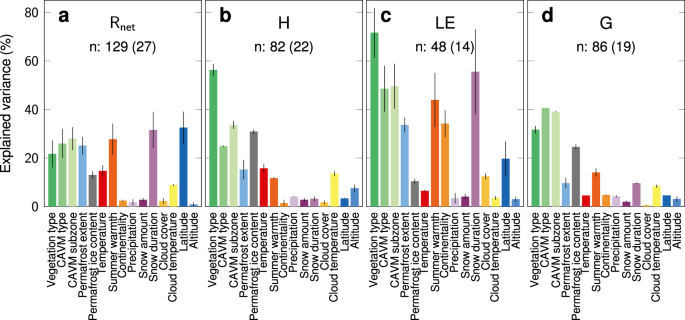新しい論文では、植生の種類が北極圏の夏における陸地と大気間のエネルギー交換の重要な予測因子であることが示されています。 A new paper shows that vegetation type is an important predictor of energy exchange between land and the atmosphere in the Arctic summer.
2023-01-11 アルゴンヌ国立研究所(ANL)
米国エネルギー省(DOE)のアルゴンヌ国立研究所やDOE科学局の大気放射計測(ARM)ユーザー施設など63の研究機関による最近の研究では、さまざまな要因が北極のエネルギー交換(陸と大気間のエネルギー移動の過程)に与える影響を評価しました。その結果、気候モデルで単純化されがちな植生の種類が、北極圏の夏におけるエネルギー交換を予測する主な要因であることがわかりました。
アルゴンヌのアシスタント大気科学者であり、この研究の共著者であるライアン・サリバン氏は、「植生タイプに違いがあることは予想していましたが、ここまでではありませんでした」と述べています。”植生タイプは、永久凍土、気温、積雪、雲量よりも、地表エネルギー収支に対して強い予測能力を有していました。”
地表エネルギー収支は、太陽からのエネルギーがどれだけ地表に到達し、どれだけのエネルギーが吸収または反射されて大気に戻ってくるかを記述する。この予算には、正味放射量、顕熱フラックス、潜熱フラックス、地中熱フラックスの4つの主要な構成要素が含まれています。正味放射量は、地球のシステムに入るエネルギー量を表します。顕熱フラックスとは、エネルギーが熱として移動し、温度変化を引き起こすことを表します。潜熱は、温度変化を伴わないエネルギー変化です。そして、地中に蓄積されるエネルギーが「地中熱フラックス」である。
今回の研究では、6月から8月にかけての北極圏の地表エネルギー収支の4つの主要な要素について、15のドライバーが及ぼす影響を評価しました。研究チームは、1994年から2021年の間に64の測定局で収集されたデータを分析しました。
研究者らは、植生の種類がエネルギー収支に強い影響を与えることを、主に2つの理由から示唆した。まず、北極圏には、北方泥炭地から地衣類に覆われた低湿地、草原まで、さまざまな植物群落が存在する。それぞれの植生群落は、気温、地形、土壌水分、永久凍土の状態など、他の様々な環境条件を反映している。また、植物は高さ、生産性、アルベド特性などが異なり、これらはすべて、土地と大気の間のエネルギー移動に影響を与える可能性があります。
また、植生の種類がエネルギー収支に与える影響は、春に積雪がなくなり秋に戻る時期によって異なることがわかり、エネルギーフラックスにおける季節性の重要性が明らかになりました。
この研究に基づく論文は、昨年10月、Nature Communications誌に掲載されました。
<関連情報>
- https://www.anl.gov/article/vegetation-has-a-substantial-impact-on-the-movement-of-energy-in-the-arctic
- https://www.nature.com/articles/s41467-022-34049-3
植生タイプは北極圏の夏の陸面エネルギー収支の重要な予測因子である Vegetation type is an important predictor of the arctic summer land surface energy budget
Jacqueline Oehri,Gabriela Schaepman-Strub,Jin-Soo Kim,Raleigh Grysko,Heather Kropp,Inge Grünberg,Vitalii Zemlianskii,Oliver Sonnentag,Eugénie S. Euskirchen,Merin Reji Chacko,Giovanni Muscari,Peter D. Blanken,Joshua F. Dean,Alcide di Sarra,Richard J. Harding,Ireneusz Sobota,Lars Kutzbach,Elena Plekhanova,Aku Riihelä,Julia Boike,Nathaniel B. Miller,Jason Beringer,Efrén López-Blanco,Paul C. Stoy,Ryan C. Sullivan,Marek Kejna,Frans-Jan W. Parmentier,John A. Gamon,Mikhail Mastepanov,Christian Wille,Marcin Jackowicz-Korczynski,Dirk N. Karger,William L. Quinton,Jaakko Putkonen,Dirk van As,Torben R. Christensen,Maria Z. Hakuba,Robert S. Stone,Stefan Metzger,Baptiste Vandecrux,Gerald V. Frost,Martin Wild,Birger Hansen,Daniela Meloni,Florent Domine,Mariska te Beest,Torsten Sachs,Aram Kalhori,Adrian V. Rocha,Scott N. Williamson,Sara Morris,Adam L. Atchley,Richard Essery,Benjamin R. K. Runkle,David Holl,Laura D. Riihimaki,Hiroki Iwata,Edward A. G. Schuur,Christopher J. Cox,Andrey A. Grachev,Joseph P. McFadden,Robert S. Fausto,Mathias Göckede,Masahito Ueyama,Norbert Pirk,Gijs de Boer,M. Syndonia Bret-Harte,Matti Leppäranta,Konrad Steffen,Thomas Friborg,Atsumu Ohmura,Colin W. Edgar,Johan Olofsson & Scott D. Chambers
Nature Communications Published:31 October 2022
DOI:https://doi.org/10.1038/s41467-022-34049-3

Abstract
Despite the importance of high-latitude surface energy budgets (SEBs) for land-climate interactions in the rapidly changing Arctic, uncertainties in their prediction persist. Here, we harmonize SEB observations across a network of vegetated and glaciated sites at circumpolar scale (1994–2021). Our variance-partitioning analysis identifies vegetation type as an important predictor for SEB-components during Arctic summer (June-August), compared to other SEB-drivers including climate, latitude and permafrost characteristics. Differences among vegetation types can be of similar magnitude as between vegetation and glacier surfaces and are especially high for summer sensible and latent heat fluxes. The timing of SEB-flux summer-regimes (when daily mean values exceed 0 Wm−2) relative to snow-free and -onset dates varies substantially depending on vegetation type, implying vegetation controls on snow-cover and SEB-flux seasonality. Our results indicate complex shifts in surface energy fluxes with land-cover transitions and a lengthening summer season, and highlight the potential for improving future Earth system models via a refined representation of Arctic vegetation types.



